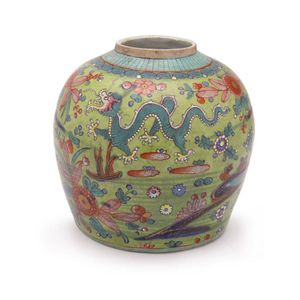Tang Dynasty Parcel-Gilt Silver Floriate Box and Cover
You must be a subscriber, and be logged in to view price and dealer details.
Subscribe Now to view actual auction price for this item
When you subscribe, you have the option of setting the currency in which to display prices to $Au, $US, $NZ or Stg.
- Foliate - Decorated with leaves or leaf-like forms.
- Gilding - Gilding is a method of ornamentation whereby a thin sheet of gold metal is applied to items made of wood, leather, ceramics, glass and silver for decorative purposes.
For furniture including mirrors, the sheet of gold is usually applied over a coating of gesso. Gesso is a mixture of plaster of Paris and gypsum mixed with water and then applied to the carved wooden frames of mirrors and picture frames as a base for applying the gold leaf. After numerous coats of gesso have been applied, allowed to dry and then sanded a coat of "bole", a usually red coloured mixture of clay and glue is brushed on and allowed to dry, after which the gold leaf is applied. Over time parts of the gilding will rub off so the base colour can be seen. In water gilding, this was generally a blue colour, while in oil gilding, the under layer was often yellow. In Victorian times, gilders frequently used red as a pigment beneath the gold leaf.
Metal was often gilded by a process known as fire gilding. Gold mixed with mercury was applied and heated, causing the mercury to evaporate, the long-term effect of which was to kill or disable the craftsman or woman from mercury poisoning. The pursuit of beauty has claimed many victims, not the least of which were the artists who made those pieces so highly sought after today. - Important - Important is a word used in the antique trade to indicate an object should be ranked above other similar objects, and is therefore more valuable.
The object could be considered important because it is by a famous designer or maker, has been shown at a major exhibition, is of exquisite workmanship, is rare or is a "one-off", was made for an important patron, and so on.
Even further up the pecking order are objects that are described in catalogue descriptions as highly important or extraordinarily important. - Incised - A record of a name, date or inscription, or a decoration scratched into a surface, usually of a glass or ceramic item with a blunt instrument to make a coarse indentation. Compare with engraving where the surface is cut with a sharp instrument such as a metal needle or rotating tool to achieve a fine indentation.
This item has been included into following indexes:
Visually similar items

Large Chinese porcelain. Ginger jar, probably dating to early 19th century with underglaze blue decoration and later added famille rose the decoration is of a mountain pagoda scene on a lime green ground, with an undeciphered iron red mark on underside, ch

A fine Chinese cloisonne covered box, Republic era, circa early to mid 20th century, the cushion shaped circular box well decorated with scrolls, flowers, bats and shou medallions between patterned borders over a teal ground, the interior and underside wit

A Rene Lalique Perruches vase, designed 1919, the baluster body moulded with a repeating pattern depicting pairs of parakeets perched on branches against a leafy background, in opalescent and frosted glass with a blue patina, inscribed R. Lalique France No

Sterling silver jewellery box, original velvet & satin lining., Birmingham 1912
